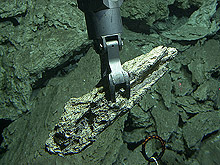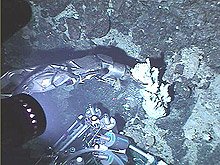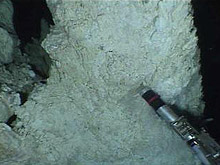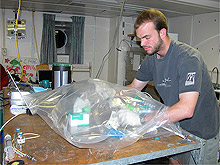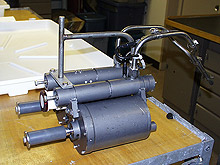
Major samplers being prepared for placement on the vehicle. The one shown in this image is called a "double pair" because it has two sampling chambers. The robotic claws of the vehicle grab onto the T-shaped handle for placement of the nozzle into the vent orifice. Click image for larger view and image credit. (HR)
Sensors, Sampling, and Analyses in Extreme Environments
Debbie Kelley
Associate Professor Oceanography
University of Washington
Sample collection and data acquisition in extreme environments is challenging. Instruments must be able to withstand the pressures associated with great ocean depths (>200-600 times those we live at), corrosive hot fluids (>700°F), cold seawater, and long periods on the seafloor. They also have to survive the onslaught of opportunistic microbes and animals looking for a new place to live. Because of the inherent difficulties of working in this environment, scientific instruments have to be innovative and durable.

Major water sample being taken from a black smoker on the Juan de Fuca Ridge. These samplers are used both in acidic systems, like black smoker chimneys, and in basic environments such as Lost City. To withstand hot, acidic fluids a lot of the parts on the samplers are made out of titanium. Click image for larger view and image credit.
Hydrothermal Vent Fluids
Collecting hydrothermal fluids and gases might seem like an easy task, but it actually requires special instruments coupled with skillful ROV operations. The first type of instrument is the major sampler , which collects fluids through a thin titanium nozzle placed inside the vent opening. When the syringe-like plunger is triggered, it extracts about 750 ml of fluid into the barrel of the instrument. The fluids are later analyzed for major and trace elements and some isotopes. Chemical analyses of the fluids collected by the major sampler help scientists understand the fluid-rock interactions beneath the surface and within the chimneys, constrain the temperature at which rocks are altered, and even show the influence of microbial processes. In addition, they may provide insight about the composition of fluids during evolution of the early Earth.
Fluid samples also provide a way to recover microorganisms that live within the fluid-saturated walls of the carbonate towers at Lost City. As vent fluids are sucked into the major samplers, micron-sized organisms that live within the chimneys are also sucked in.
Once the samplers are onboard, microbiologists take small portions of the fluids and put them into test tubes filled with different nutrients to try and grow the organisms. Other fluid samples are filtered so that the researchers can extract DNA from the microbes and look at their genetic composition.
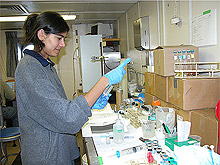
Mausmi Mehta, a graduate student in Oceanography at the University of Washington is shown processing microorganisms on the 2003 Lost City cruise. The syringes are filled with different nutrients and gases and inoculated with organisms obtained form rock and fluid samples. The tubes are then placed in ovens at a variety of temperatures (usually 50 to 90°C) to grow the organisms. Click image for larger view and image credit. (HR)
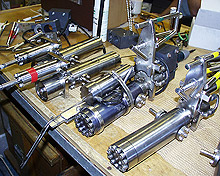
Gas-tight bottles readied for deployment. The titanium bottles withstand the harsh vent environment. The small snorkel is deployed within the vent orifice and the bottle is then "triggered" to immediately suck in vent fluid. Vent fluid temperatures are taken before sampling. Click image for larger view and image credit. (HR)
Gases from the Deep
Another instrument used to collect hydrothermal fluid is the titanium gas-tight sampler. Like the major sampler, it consists of a nozzle attached to a barrel, which collects the fluid after sampling. However, it is less than half the size. Unlike the major samplers, which can depressurize and lose gas as they ascend to the surface, gas-tight samplers are specifically designed to stay completely sealed to prevent any gas loss. Before use, the air is removed from gas-tights to minimize contamination and achieve nearly instantaneous sampling. If seawater is sucked into the major and gas-tight samples it is harder to analyze their compositions. ROV pilots have to be very precise when placing the nozzle in the vent and taking the sample.
After sampling, a gas extraction line onboard the ship is used to remove gas from the sampler, dry the gas, and package it into a glass ampule (small glass capsule) for later analysis of gas composition, helium content, and stable and radiocarbon isotopes. Helium isotopes can indicate whether there are magmatic processes impacting the development of the vents, while carbon isotopes provide age information and insights into the origin of the gases. For example, methane, a dominant gas at Lost City, is generated by seawater alteration of the mantle rocks beneath the field, and perhaps by millions of microorganisms that live within the carbonate chimneys.
Rocks and Life
Rocks: Rocks and life at Lost City are intertwined. To sample the vent chimneys and the underlying crustal rocks we use the strong jaws located at the ends of the manipulator arms on the robotic vehicles . The "fingers" on the jaws pry the rocks off of the cliffs, or break pieces of the chimneys and then store them in baskets located at various places on the vehicle. Once onboard, the rocks are cataloged, extensively imaged and described and then stored in a variety of ways for follow-on geochemical and biological analyses.
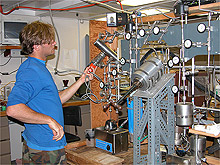
A gas-tight sampler is attached to a gas extraction line (titanium cylinder being heated with a heat gun). Giora Proskurowski, a recent graduate student in Oceanography at the University of Washington, is studying the gases at Lost City in collaboration with Dr. Marvin Lilley. The gases are trapped within this complex line by opening and closing a variety of valves and by cooling of the gases under vacuum. Click image for larger view and image credit. (HR)
Animals: Life thrives on the surfaces of the rocks and within the chimneys. Researchers studying the larger animals at Lost City use tweezers to sample most of the animals because at Lost City, the "large" animals are rarely more than a 1/2 an inch in size and most are much smaller. Animals are also collected using suction samplers (underwater vacuum cleaners) attached to submersibles and robotic vehicles. A nozzle attached to a suction tube is used to "vacuum" the surfaces of the chimneys. Animals are sucked into a variety of small chambers and then brought to the surface. These animals are preserved in a variety of ways and photographed with a special microscope. Some animals are frozen so that their DNA can be later analyzed to determine what kind of species they are. One of the most fascinating things about Lost City is that, although animals are not very abundant within the field, their diversity is as high as or higher than black smoker systems on the Mid-Atlantic Ridge. Numerous species never before seen where recovered on the expedition to Lost City in 2003, and we believe that we may find more on this cruise.
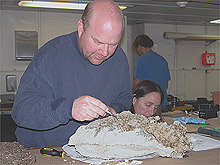
Dr. Tim Shank, from Woods Hole Oceanographic Institution, sampling animals from Lost City carbonate samples during the 2003 expedition. Tim has found many new species of animals at Lost City. Dr. Gretchen Früh-Green from Zürich, is working with Tim, describing the rocks that the biological samples are taken from. Click image for larger view and image credit. (HR)
Microbes: Whenever samples of rocks come onboard, there is much excitement in the laboratory by the microbiologists and a rush to get rock samples as fast as possible. Many of the microbes that live within the chimneys cannot tolerate oxygen. If left too long they will die. Because of this, the microbiologists rapidly subsample the rocks by breaking small pieces off. They immediately transfer some of the material into specially designed "airtight" glove bags that are filled with nitrogen gas. The conditions within the bag are anaerobic, meaning that there is no oxygen. Built-in gloves that protrude into the bag allow the microbiologists to process the samples without introducing air into the environment. Similar to processing of the vent fluid samples, some of the rock material is placed in test tubes with a variety of nutrients and gases (e.g. methane, carbon dioxide) added to them. Special gas-tight caps are used to seal the test tubes, keeping the gas in and the air out. These tubes are then placed in ovens set at different temperatures to grow or culture the organisms. Most microbes are very difficult to grow, however, and so a lot of the information on these organisms comes from analyzing their genetic composition using DNA and RNA analyses. To do this, the rocks are frozen at -40 to -112 Fahrenheit!



























